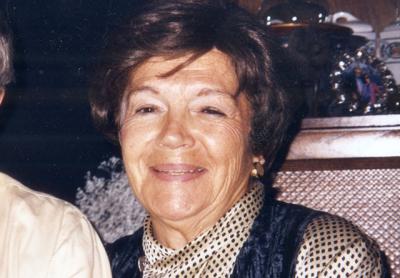Simone V. Marshall, 93

Simone V. Marshall, who was brought up in Paris but came to the United States to train and work as a psychoanalyst, died at home in Springs on Aug. 22 after a long illness. She was 93.
It was her abiding interest in human psychology that led her from France to Columbia University, where she met her future husband, Robert J. Marshall, whom she called Bob.
“After World War II, mired in the dank archives of Parisian libraries, translating U.S. Army Jeep manuals into French,” she wrote in an autobiographical essay to be published in Psychoanalytic Inquiry, a professional journal, “I dreamed of being a psychotherapist. When I graduated to translating American psychological journals, I fantasized [about] being a psychoanalyst.”
She was at the Sorbonne in the early 1950s when she spotted a poster describing a Fulbright Scholarship to pursue a doctorate in clinical psychology in the States; she applied, won, and soon found herself sailing on the Ile de France for New York City and Teachers College, Columbia. It was there that she met Mr. Marshall, who remembers her in those first encounters as a glamorous figure surrounded by suitors (“a queen bee swarmed by workers”).
Ms. Marshall, whose maiden name was Verniere, wrote in the aforementioned essay that she was eventually, through her own analysis, able to identify her father’s experiences in World War I as the source of her ambition to work in the field. Urbain Verniere had manned a cannon for four years at Verdun, and suffered severe depression as a survivor of that war.
While working on her doctorate, Ms. Marshall supported herself by teaching French and appearing on a variety of radio programs, including “Name That Tune,” on which she earned the impressive sum of $500. With her future husband and a band of friends she spent one memorable summer traveling cross-country in a DeSoto convertible. Simone and Bob were married in the autumn of 1953, over the objections of her father back in France.
While writing her dissertation, Ms. Marshall worked as a child therapist, but then Mr. Marshall, facing the prospect of draft during the Korean War, entered training as an Army medical officer at Letterman Hospital in San Francisco. Their daughter Gabrielle, named after her French grandmother, was born a short while before Mr. Marshall was posted to work at Fort Dix, N.J., where he became chief psychologist.
While living at Fort Dix, and completing the dissertation (“Personality Correlates of Peptic Ulcer Patients”), Ms. Marshall found a job at New Lisbon, an institution for mentally disabled adults, and then at a clinic at Rutgers University. Although she disliked the military in general, she found there were perks to life with the Army, including medical services, affordable groceries at the P.X. — and dirt-cheap flights to France, where Ms. Marshall reconciled with her parents during a vacation with baby Gaby in arms.
Finally, in 1959, as Ms. Marshall wrote, she “was ready to storm the portals of psychoanalysis,” armed with her Ph.D. as well as an M.A. in developmental psychology.
The family settled in Westchester County, buying a house on a G.I. loan, and she became a school psychologist in Ossining for a time. The Marshalls’ second child, Annette, was born in this period. After further training at the White Institute, Ms. Marshall worked for a time with a group practice in Yorktown Heights, then launched a home-based practice in Croton-on-Hudson.
The Marshalls’ house overlooking the Hudson was also the scene of many large parties, for the Fourth of July, New Year’s Eve, birthdays, and anniversaries. “We held hilarious themed costume parties and an uproarious event where people were requested to tell one eighth-grade joke and two fourth-grade jokes,” Ms. Marshall wrote.
It was the era of feminism and “consciousness raising,”and she began running a free women’s therapy group out of her living room. It evolved into the Croton-Cortland Women’s Center, which became a force for change in the community, advocating for equality in school sports and math and science education for girls, among other things.
It was when Gaby and Annette were in college that the Marshalls began to consider moving back down to Manhattan. The move to the city coincided with the beginning of a protracted search for a place to build a second home. After 15 years of seeking just the right weekend property, they settled on East Hampton and a lot in Springs overlooking Gardiner’s Bay, where they built a house with a view in the early 1980s. The choice was made not just because of the proximity of colleagues and friends from the psychoanalysis field but because Annette Marshall, now Annette Franey, had married and was raising a family here.
Annette Franey, a physical therapist in East Hampton, and Gabrielle Marshall-Salomon, a psychiatrist in Summit, N.J., survive, as does their father, Robert Marshall.
Ms. Marshall continued her practice, working from and running group-therapy session in an office on the Upper West Side, but in recent years, as she and her husband began spending more and more time on the East End, she let her professional schedule dwindle.
Most recently, more time was spent with grandchildren (of which there are three), organizing photo albums, and planning the couple’s next vacation. She wrote about her long and unusual life, and described bidding goodbye to old patients after so many years, and facing her own aging, like this:
“I shed a few tears and in the words of Edith Piaf, ‘Je ne regrette rien.’ There is an enhanced sense of ease, curiosity, puzzlement, but with an odd mixture of my old emotional companions — insecurity and accomplishment. And this is where I must say, ‘Au revoir.’ ”
